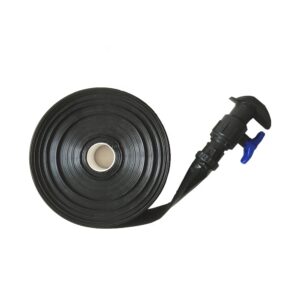How do you install a micro spray tube in a garden or landscape?
Installing a micro spray tube in a garden or landscape involves the following steps:
Plan and Design: Determine the layout and irrigation needs of your garden or landscape. Identify the areas that require watering and the specific plants or zones that will be served by the micro spray tubes.
Select the Micro Spray Tube System: Choose a micro spray tube system that suits your watering requirements. Consider factors such as the flow rate, coverage area, and water distribution pattern of the micro spray heads.
Gather Materials: Collect all the necessary materials for installation, including the micro spray tubes, micro spray heads, connectors, stakes, and any additional fittings or accessories recommended by the manufacturer.
Prepare the Water Source: Ensure you have a suitable water source nearby, such as a garden hose or an irrigation system supply line. If needed, install a pressure regulator or filter to optimize the water pressure and quality for the micro spray tube system.
Lay Out the Micro Spray Tubes: Start by laying out the main micro spray tube along the desired watering areas. Cut the tube to the desired length using a tubing cutter or sharp knife. Lay the micro spray tubes in a straight line or follow the contours of the landscape.
Install Micro Spray Heads: Attach the micro spray heads to the micro spray tubes at the appropriate intervals, depending on the watering needs of the plants or zones. Make sure the spray heads are securely attached and facing the desired direction.
Connect the System: Use connectors or fittings to join the micro spray tubes, ensuring a watertight connection. If necessary, use tees or elbows to create branch lines for different watering zones or to navigate around obstacles.
Secure the Micro Spray Tubes: Use stakes or clips to secure the micro spray tubes to the ground. This helps prevent movement or displacement during operation and protects them from accidental damage.
Test the System: Turn on the water supply and check for any leaks or issues with water flow. Adjust the water pressure if needed using a pressure regulator. Ensure that the micro spray heads are providing the desired spray pattern and coverage.
Fine-tune and Maintain: Make any necessary adjustments to the micro spray heads’ positions or angles to achieve optimal coverage. Regularly inspect the system for leaks, clogs, or damaged components. Clean or replace clogged or malfunctioning micro spray heads as necessary.
Remember to consult the manufacturer’s instructions and guidelines specific to your micro spray tube system for detailed installation procedures and any additional considerations.
What are the key features and components of a micro spray tube?
The key features and components of a micro spray tube system typically include:
Micro Spray Tubes: These are flexible tubes made of durable materials such as polyethylene or PVC. They come in various lengths and diameters and are designed to deliver water to the micro spray heads.
Micro Spray Heads: Micro spray heads are the nozzles or emitters that release water in a fine spray pattern. They are attached to the micro spray tubes and come in different types, such as fixed spray heads, adjustable heads, or rotating heads, allowing for customization of the watering pattern and coverage area.
Connectors and Fittings: Connectors and fittings are used to join the micro spray tubes together or to connect them to the water source. micro spray tube These components ensure a secure and leak-free connection between the different parts of the micro spray tube system.
Stakes or Clips: Stakes or clips are used to secure the micro spray tubes to the ground, keeping them in place and preventing movement or displacement during operation. They help maintain the desired alignment and protect the system from accidental damage.
Pressure Regulators: Pressure regulators are optional components but can be included in the system to control and maintain the desired water pressure. They help ensure optimal operation of the micro spray heads and prevent over or under-watering.
Filters: Filters can be integrated into the micro spray tube system, especially if the water source contains debris or sediments. They help prevent clogging of the micro spray heads and maintain proper water flow and distribution.
Optional Accessories: Depending on the specific micro spray tube system, there may be additional optional accessories available, such as tubing cutters for precise tube length adjustments, tees or elbows for branching or direction changes, and plugs or end caps for sealing off the system.
These components work together to create a customizable and efficient micro spray tube system for precise and targeted irrigation in gardens, landscapes, or specific plant zones. It is important to consult the manufacturer’s instructions and guidelines for the specific micro spray tube system you are using to ensure proper installation and operation.

Comments are Disabled